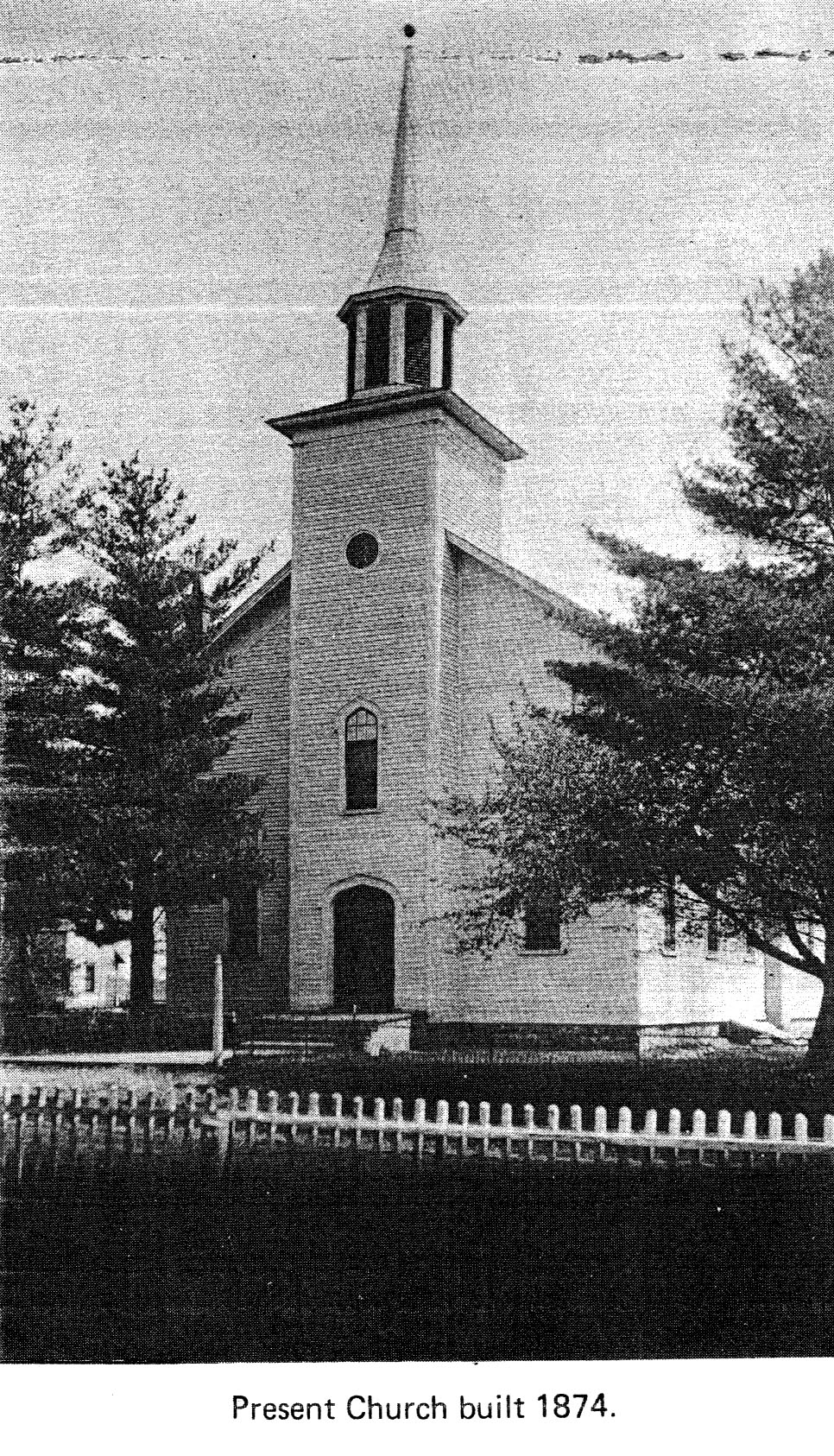
Beaverdam Reformed Church
100 Years - 1870 - 1970

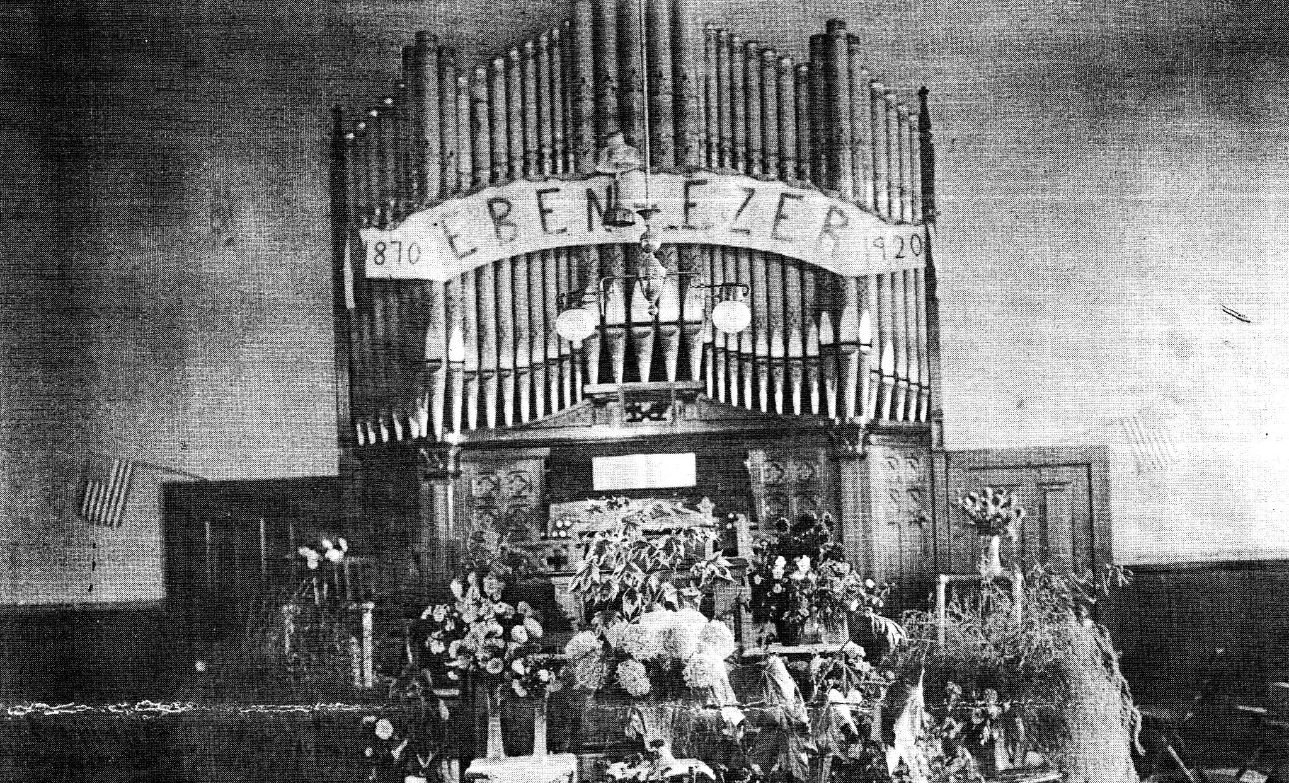
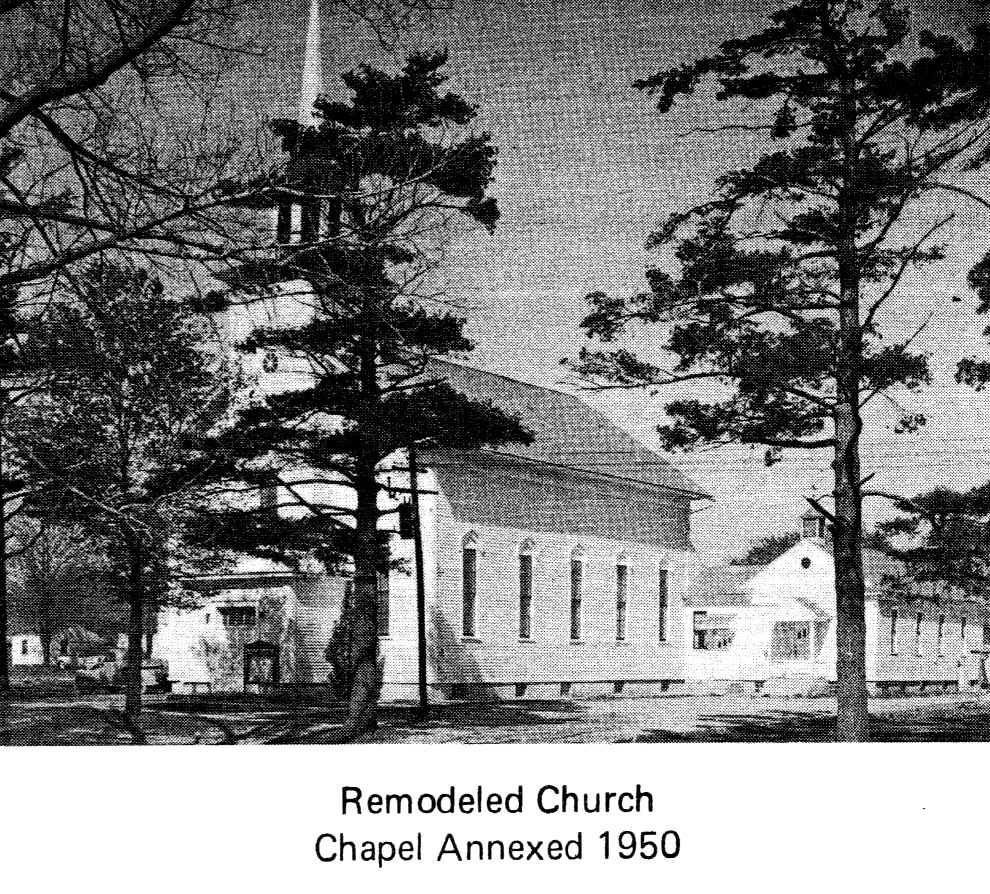
Organ donated by by John and Martin Bekius in 1905 in memory of their mother.
Our Pastors
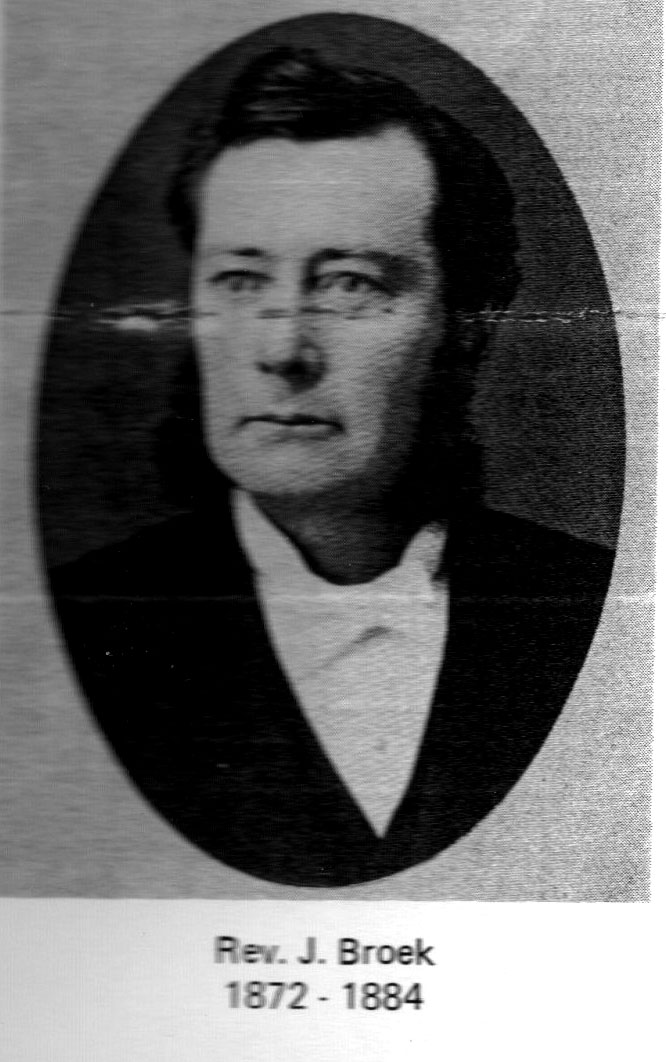
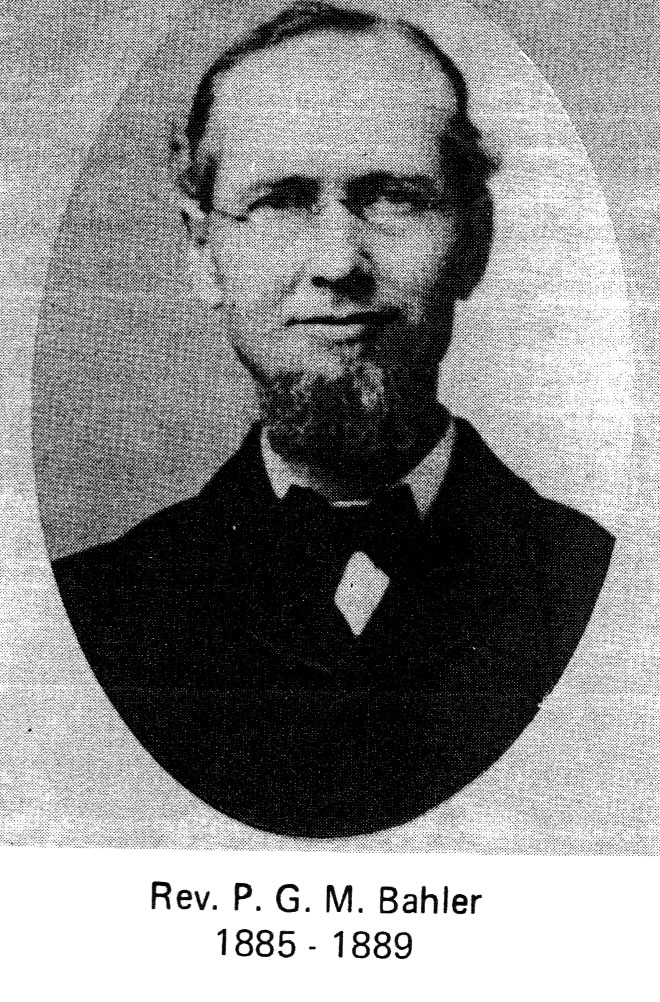
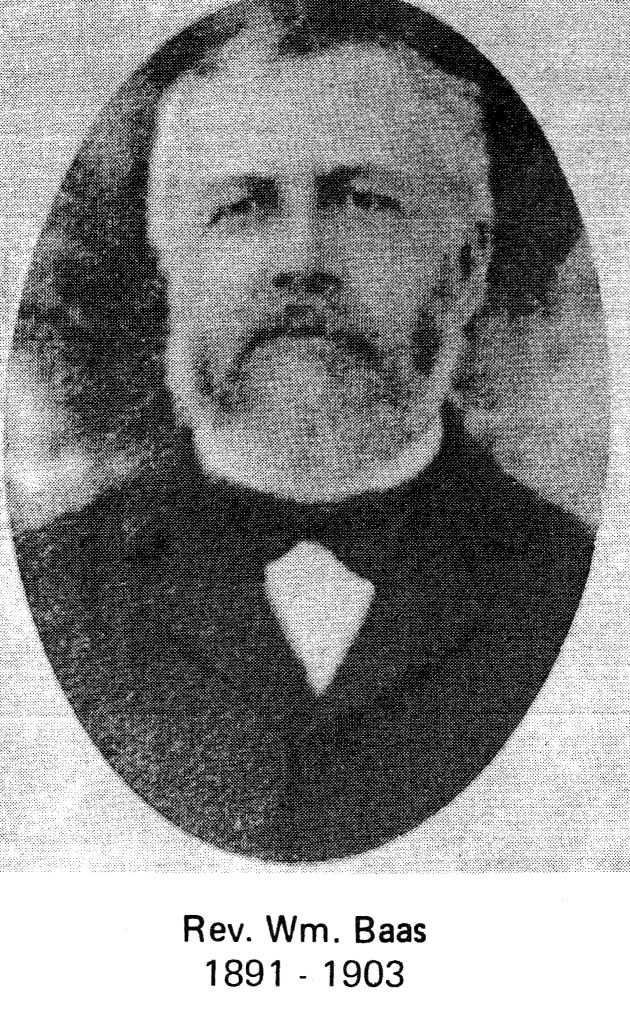
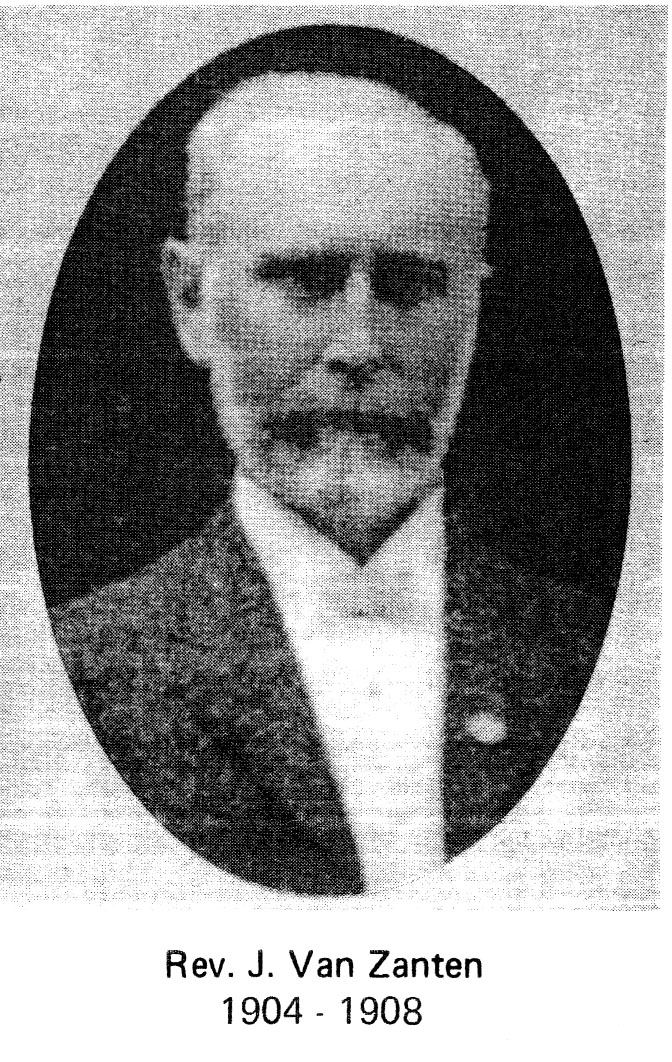
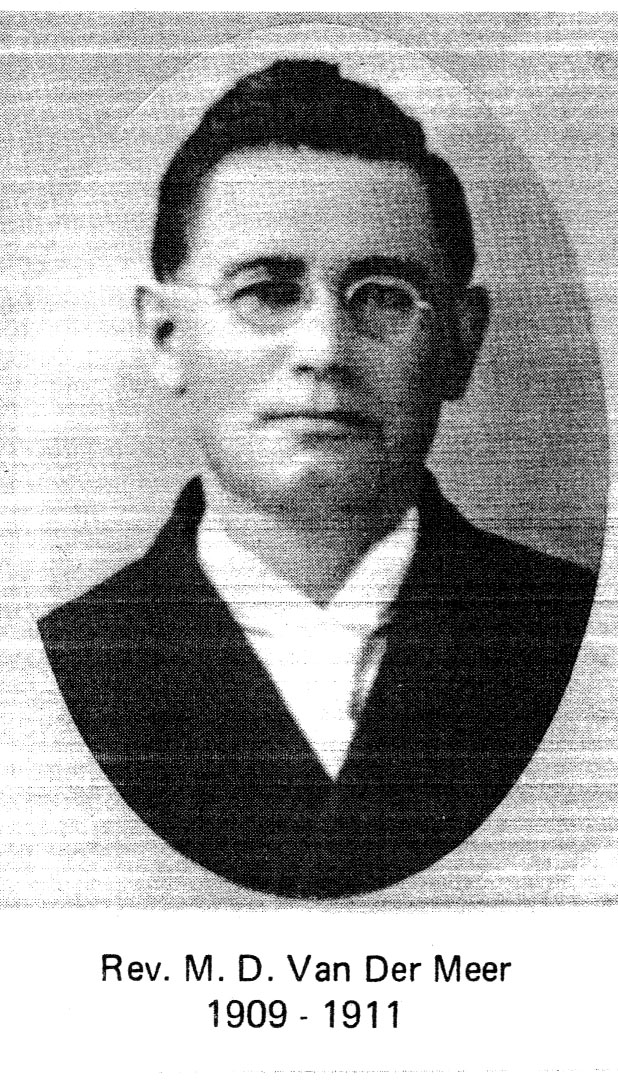
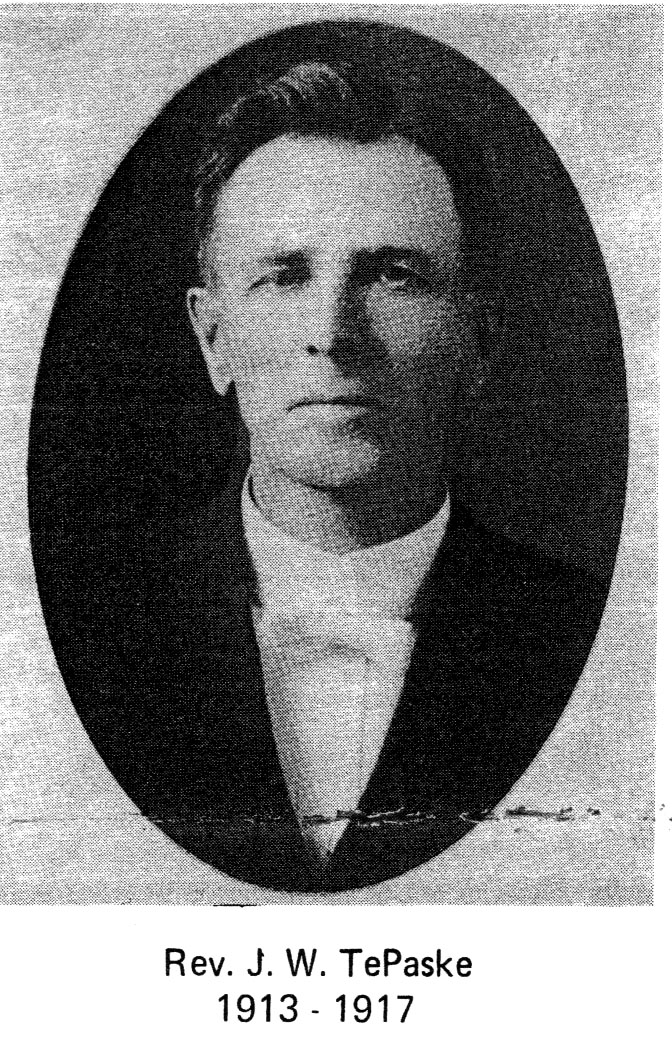
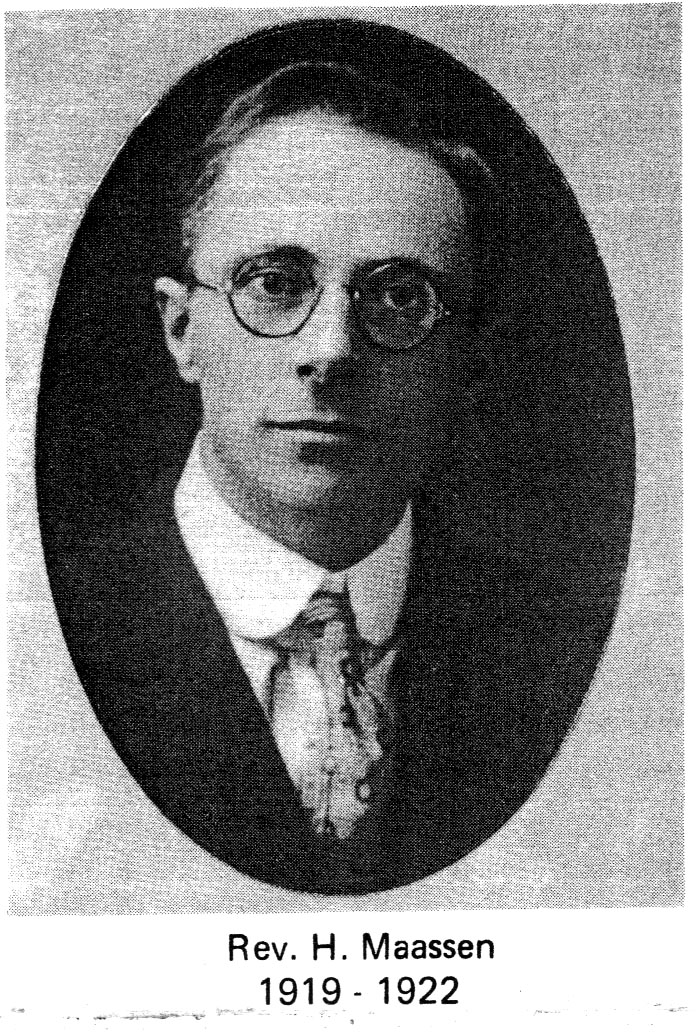
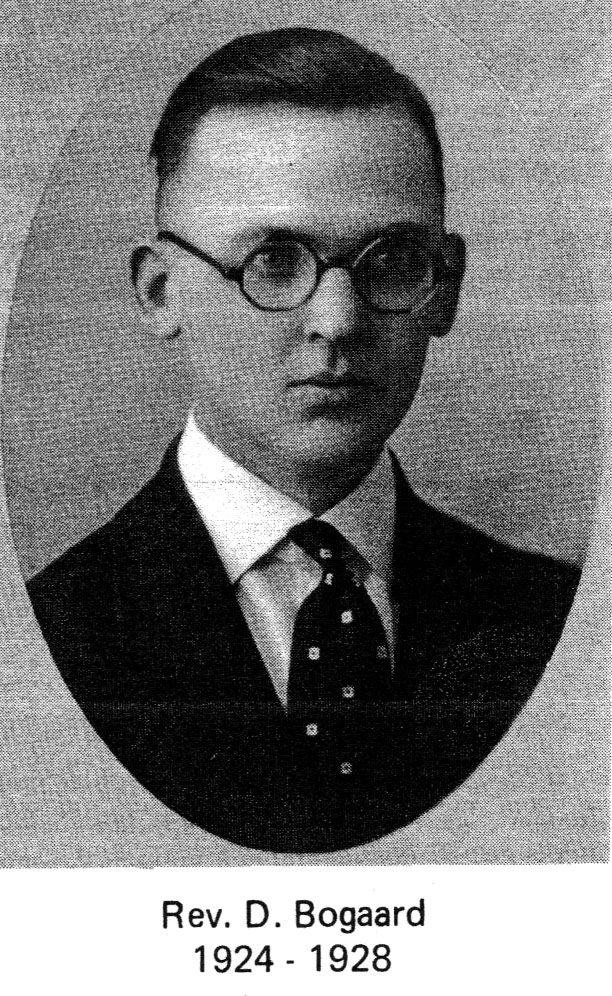
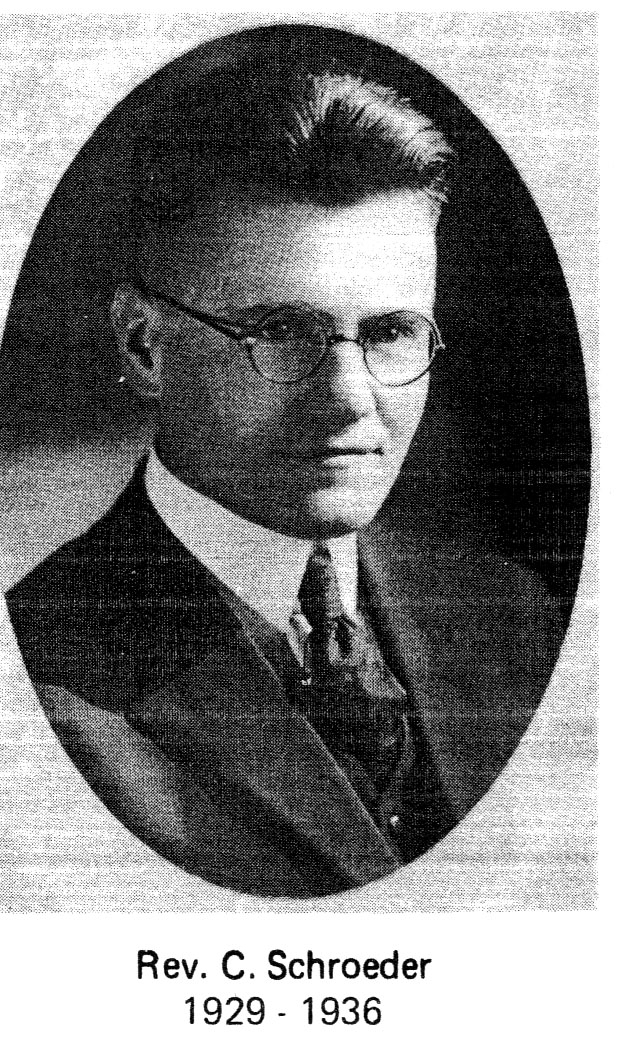
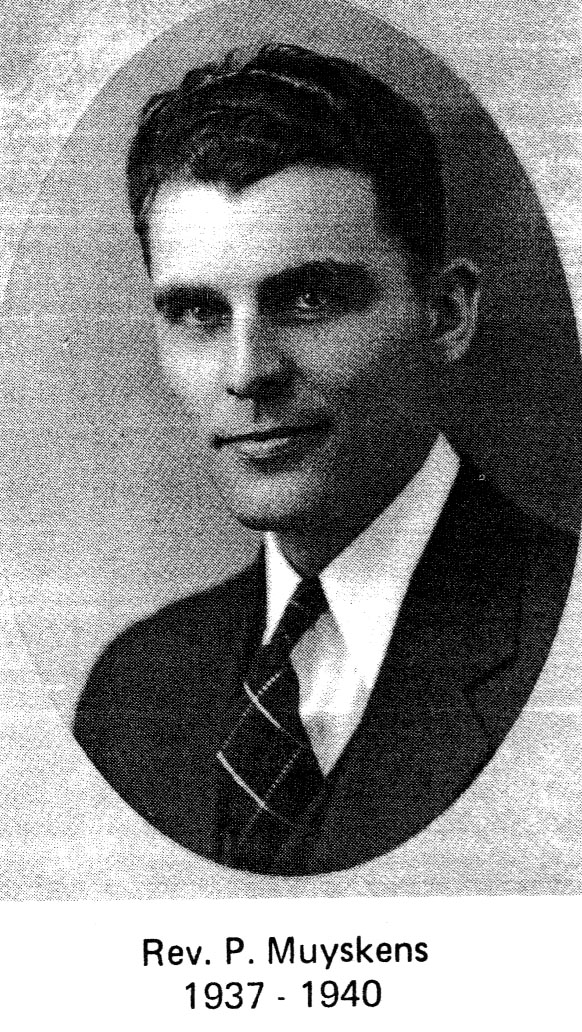
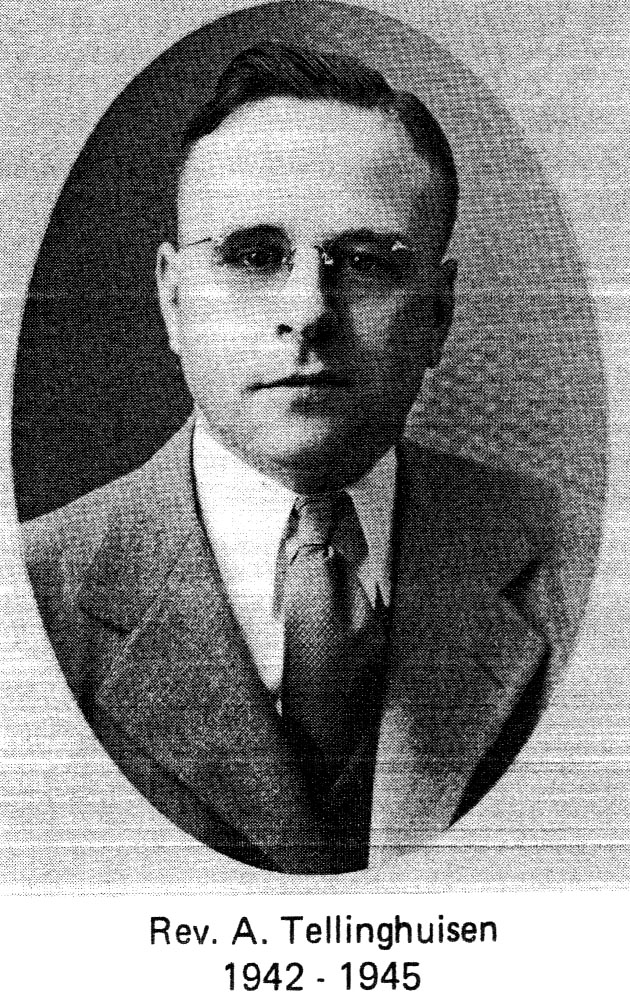
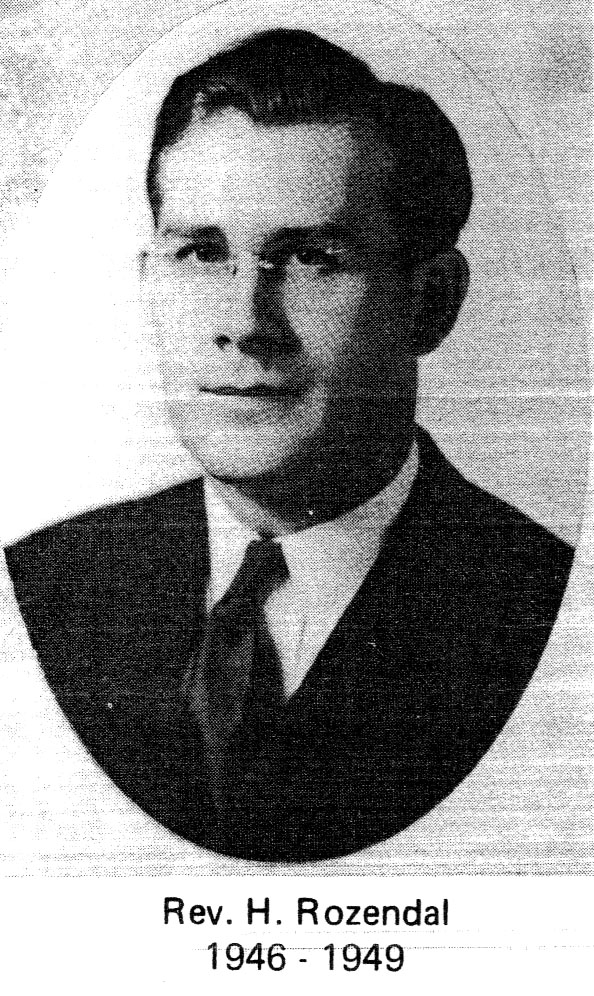
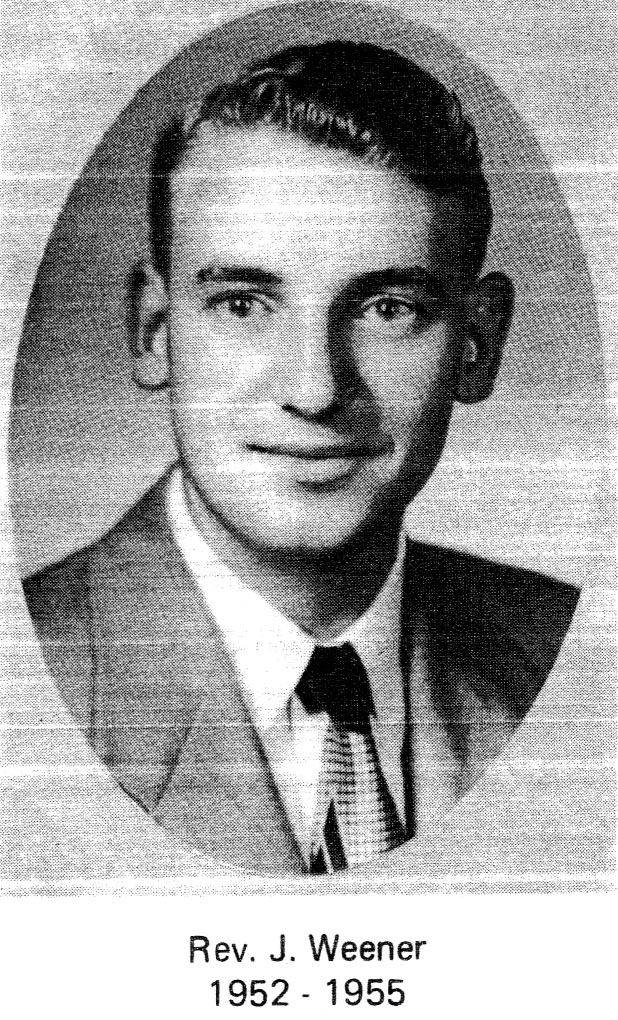
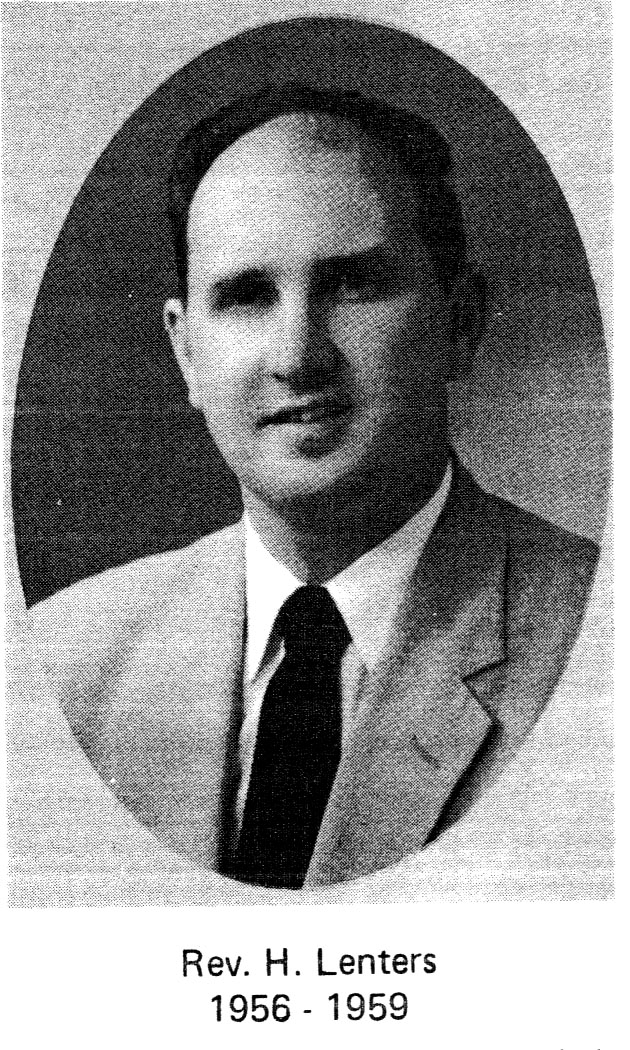
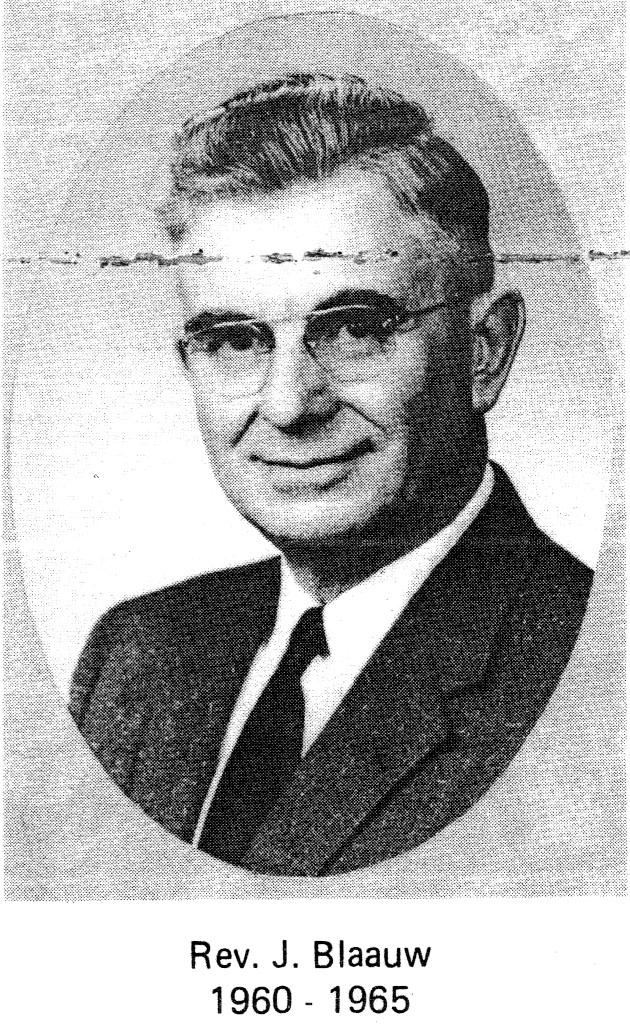
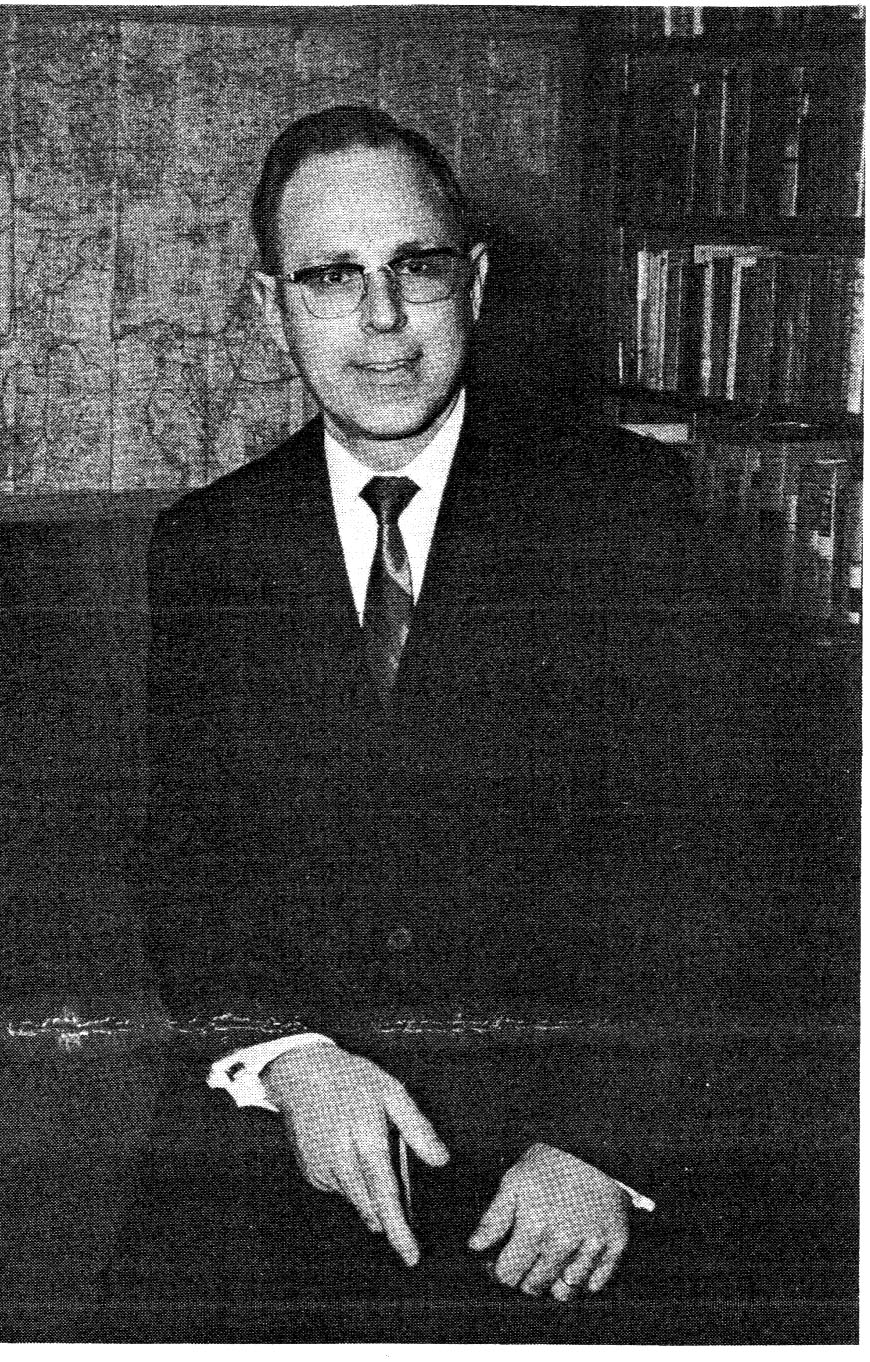
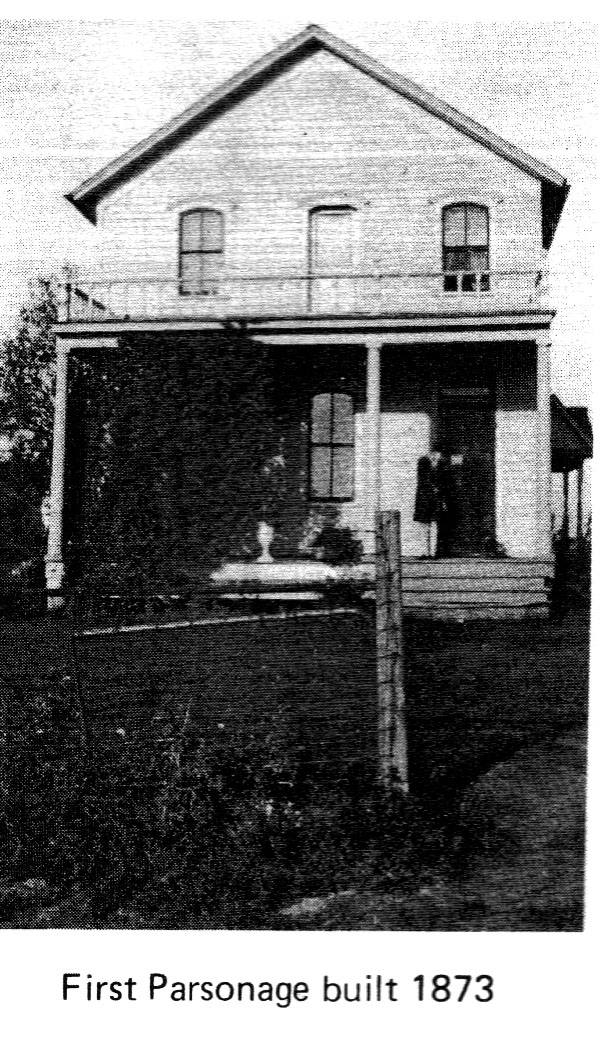
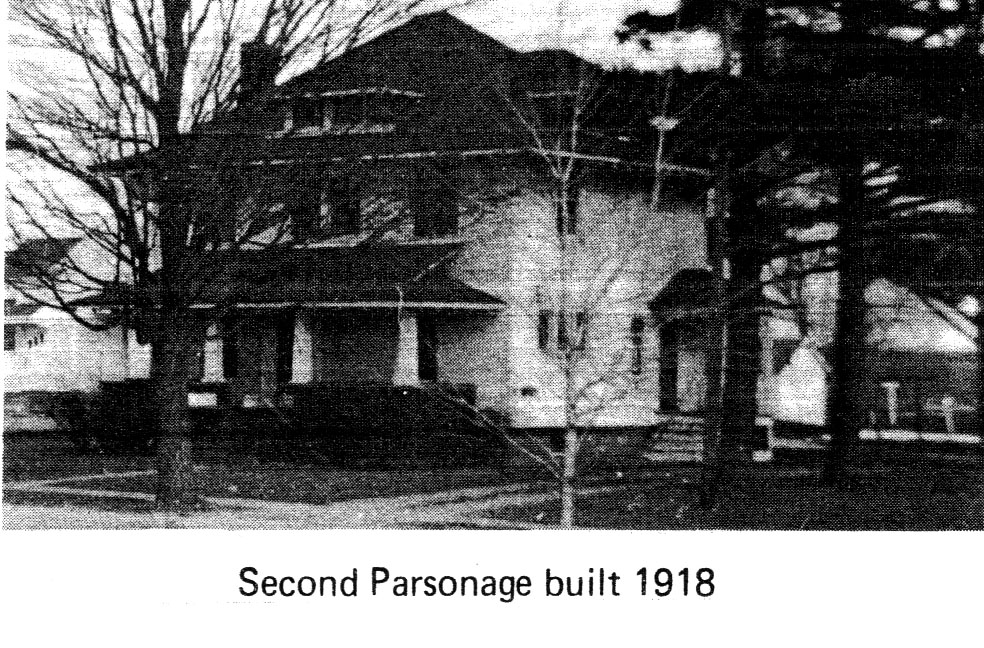
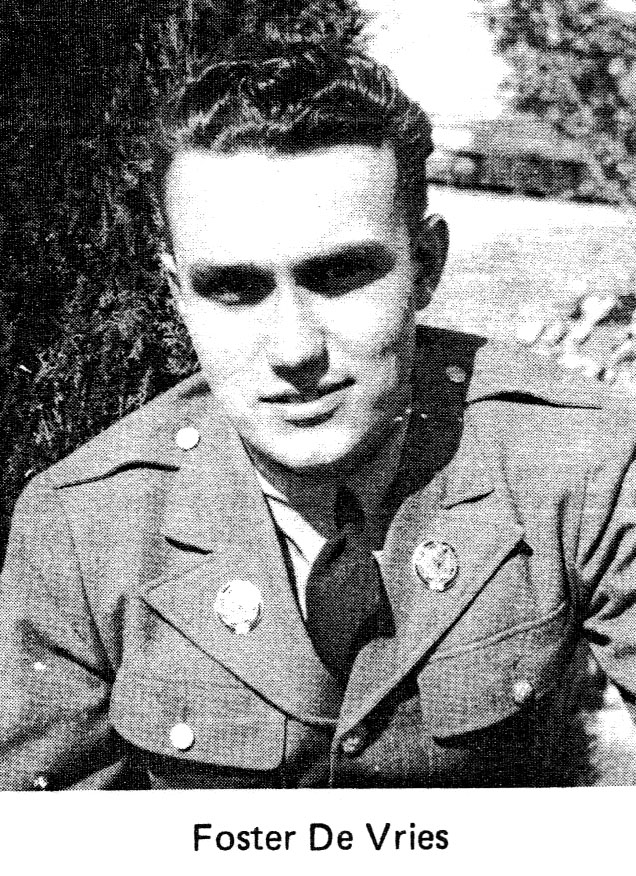
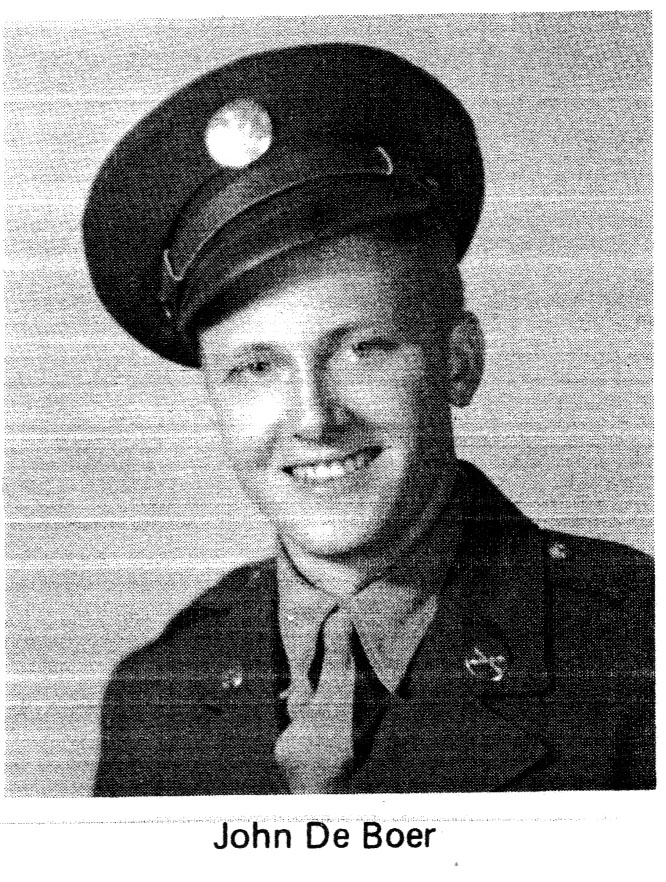
Young Men of our church killed in World War II
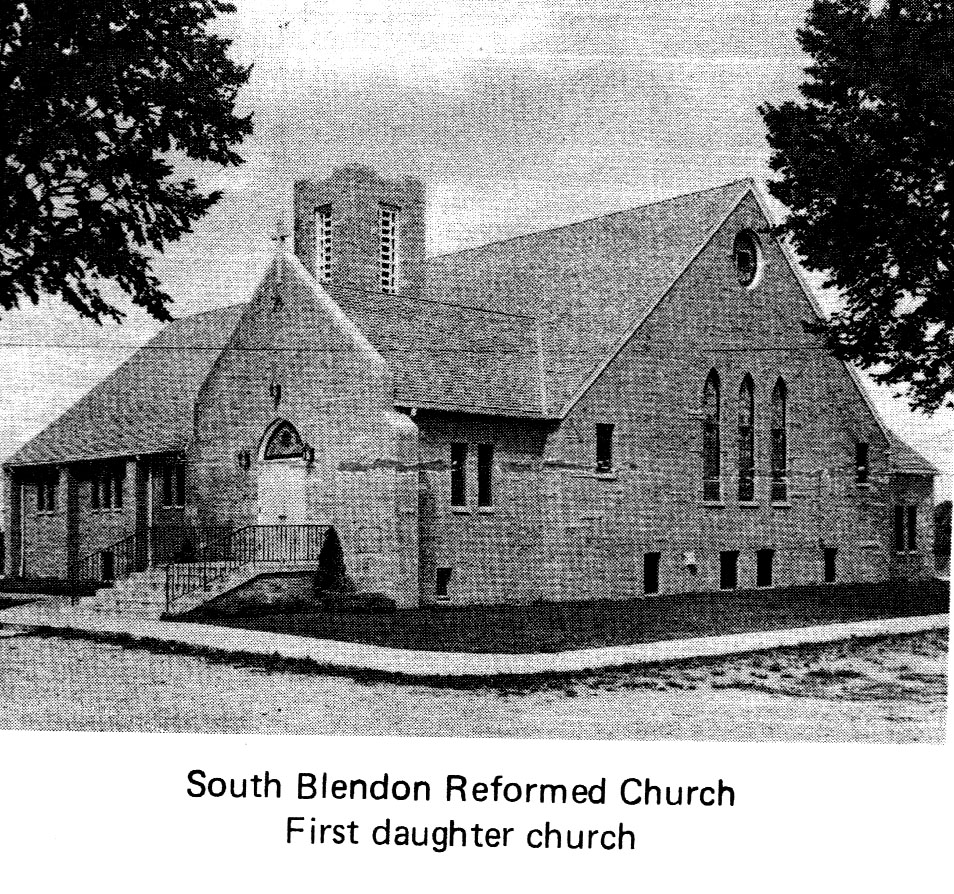
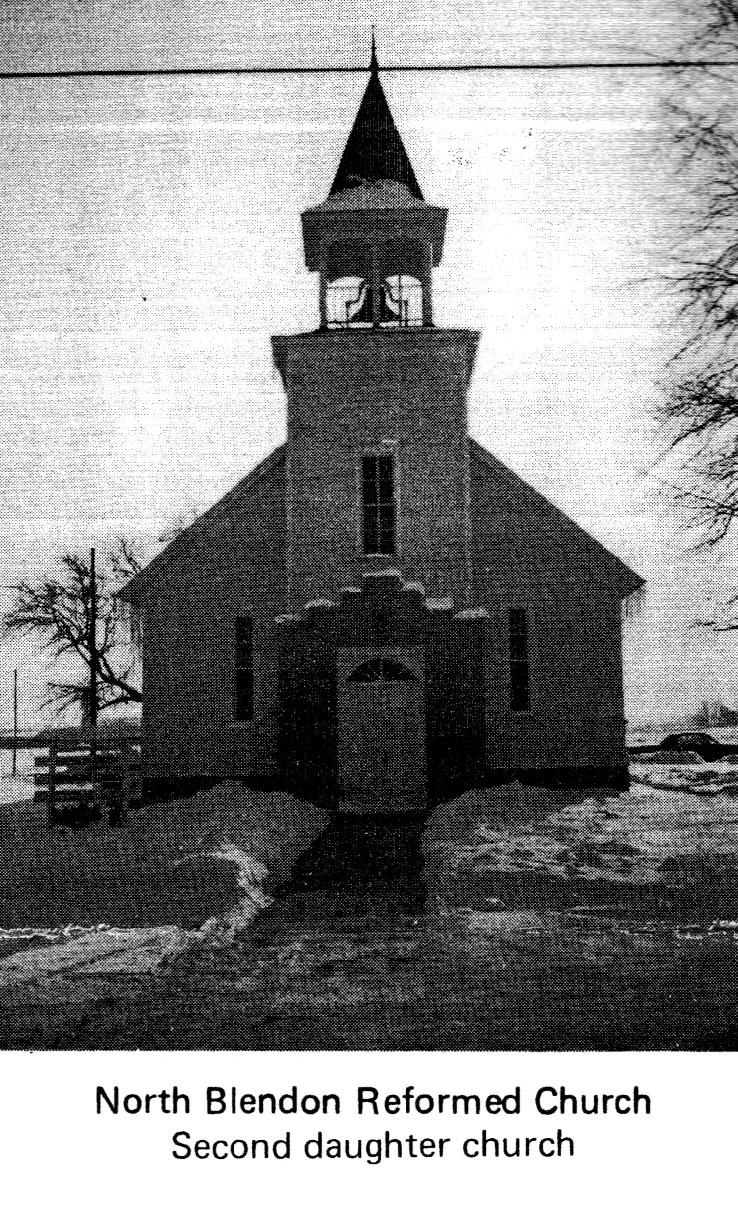
Beaverdam Reformed Church
100 Years, 1870 Ė 1970
|
On March 14, 1870 a committee of Classis Holland of the Reformed Church, convened a meeting at "The Beaverdam" for the purpose of organizing a Congregation. Rev. Kuiper addressed the meeting and Rev. Bolks, chairman of the committee, opened the meeting with prayer. Twenty-eight members were accepted on Certificates, and three members on Confession of faith. H. Van Wieren and L. Sturing were elected as Elders; and J. Zoet and M. Scheele were elected as Deasons. Their installation took place 14 days after the following Sunday. The first Consistory Meeting was held at the home of H. Van Wieren on June 2, 1870. At the request of the consistory, Elder Quirinus Huyser of the mother church (Zeeland, 1st Reformed), met with them. Q. Huyser was elected President; and M. Scheele, clerk. The first church building was erected within one year. It was a very simple building, probably not as large as our present chapel. Since no mention is made in the church records of the expense of furnishing this building, it is probable that the congregation sat on makeshift benches. It did, however, have curtains at the windows. The first church building was located on the present site of the Beaverdam Cemetery. How did Beaverdam get along at first without a pastor? Among the "Christian Seceders" (those who left the Netherlands State Church with De Cock and Van Raalte) there was at first a great shortage of ministers; so the churches had lerned to get along without Pastors or Pulpit Supply. In the absence of a minister, an Elder would lead in prayer, read the Law of God or the Apostleís Creed, read the Scripture, and then proceed to read a printed sermon written by some highly respected minister of former days. Every well read man had a number of printed sermons in his home as they were a popular form of devotional literature. The singing was led by the "voorsinger" (song leader). The Dutch Psalms were sung as full chorales (all notes of equal length) to the tunes John Calvin introduced in Geneva. It was considered a sign of orthodoxy to sing them very slowly by our standards. Beaverdam, of course, had no organ at that time. The offering was taken with a small bag on the end of a long pole. The Deacon receiving the offering held the bag before each worshipper in turn, as he worked his way from front to back. There was no "just passing the plate". When the Deacon held the bag in front of a person, that person gave even if he had given in a service earlier that day. On September 27, 1871, Beaverdam called its first pastor. His name was Johannes Broek, a student, and he received 10 of the 13 votes cast. A second ballot brought the same result. After further discussion of the conditions of the call, the meeting was closed with the singing of an "edifying song" (not a Psalm); and prayer by the moderator, Rev. Uiterijk of Vriesland. On October 15, 1872, a Congregational Meeting was called to decide on the building of a parsonage, and choose the site of same. Fourteen members voted for the building of a parsonage, and five member voted against it. G. Otto, teacher at Huyser School, moved to build the new parsonage on a new site one mile west of the old site, on condition that fifteen heads of families from the "Westside" (who were meeting in Huyser Schoolhouse) be invited to share all expenses. The vote on this motion was twelve in favor, two against. At the Congregational Meeting held March 20, 1873, Rev. Broek was voted a raise in pay. The "raise" consisted of free firewood, with the condition added that if the minister took a call elsewhere he had to leave the remainder of his firewood for use of this church. In 1873, the greatest problem of the Consistory consisted of negotiations with the "Oostzijde" (Eastside) and "Westzijde" (Westside). The Eastsiders were those who wanted the new parsonage and the proposed new church built at the site of the first church, now the site of the Beaverdam Cemetery. The Westsiders were those fifteen families who were members of the Zeeland Church, and met for Sunday services in the Huyser schoolhouse, at the corner of Quincy and 80th Avenue. The Westsiders had agreed to unite with the Beaverdam Church on two conditions: 1) That Rev. Broek would lead worship at the Huyser schoolhouse every other Sunday until the new church should be finished. 2) That the new church would be built at its now present site. Feeling on the issue of the church site ran high. It was hard to satisfy the parties. On March 3, 1874, a petition was presented to the Consistory with thirty-five signatures. Not all the signers were members of the church. The petitioners asked that the new church be built at the old site (now the Beaverdam Cemetery). The Consistory refused to grant this request because: 1) A Congregational Meeting had already decided the
matter. The building of the new church brought the struggling young church into great financial difficulties. There were no banks or other financial institutions in pioneer communities willing and able to finance the building of the church. The church borrowed $200 from a private party at 10% interest. Later the church decided to sign Notes to raise money by this means. Beaverdam was promised a loan from a denominational fund for this purpose "when any money became available", but none became available. Zeeland Church was appealed to for help. Finally the church Poor Fund was drawn upon to buy nails: an almost unthinkable thing to do in those days. When the time came to buy pews, neither money nor credit was available. Finally in January, 1875, Deacon H. J. Beld took a $400 mortgage on his farm to enable the church to buy pews. The Consistory gave Mr. Beld a mortgage for the same amount on the church property as security. The construction of the church building was a purely local affair. Deacon J. Westrate drew up the plan for the church building, and gave the following estimate of its cost: The complete building - $1200. (Cost of steeple alone was $150). To finish outside of building with floor and steeple $750. This includes one coat of paint. J. Westrate also supervised the construction of the church building, for which he received 25c a day more than the other workmen. The building committee consisted of J. Schneider, J. Kieviet, S. Bekius, J. Bos, W. Top, H. Van Wieren, D. Achterhof, J. Huyser, D. Vereeke and D. Schut. Dedication of the church was to be held on February 16, 1875; with a Dutch service at 2:00 p.m., and an English service at 7:00 p.m.; but due to the bad weather the dedication was postponed until February 23. The text at the dedication was Psalm 126:3 "The Lord hath done great things for us; whereof we are glad." The Consistory Minutes for February 22, 1875, contains the following interesting information: Resolved to ask Rev. Pieters, pastor of First Holland Reformed Church, the cost of the livery team the Rev. used to come to the dedication of the church. (Unless the clerk made a mistake in the date, this meeting being a day before the actual dedication on February 23, 1875, Rev. Pieters actually made the trip on the 16th (the date originally planned for the Dedication); but due to bad weather it was not held then. Therefore, Rev. Pieters made his trip through the blizzard in vain. In those early days every family in the church was supposed to bring a couple cords of firewood to the church and parsonage. This brought it problems. Sometimes people would b slow in making deliveries, at other times there would be much green firewood; but very little dry enough to burn. Later people were given their choice of giving two cords of wood; or to give $1.50 for each cord. Finally members were simply asked for $1.50 whenever firewood was needed. Other than soliciting firewood, the Deacons went about in the congregation several times a year to collect the ministerís salary. It was the custom to read aloud, at the annual Congregational Meeting, the amount each family had given toward the Pastorís salary. Possibly this practice made the task of collection easier. In February, 1875, an offering was taken for the needy in Kansas and Nebraska. The offering amounted to $52; a very large sum considering the poverty of the times. On February 22, 1875, the Consistory hired J. Schneider to serve as janitor for $30 per year. ON April 19, 1875, the Consitory appointed two Elders to talk to J. Elenbaas about promises the church had made to him involving grubbing out some of his stumps. (It seems that J. Elenbaas had given the church its building site on condition that the church members grub a certain number of stumps from his fields.) On June 9, 1876, G. Otto, the teacher of the Huyser School asked permission to use the church during the week for four weeks to conduct a class in singing. His request was unanimously denied! In April, 1877, some of the members of Beaverdam Church living near what was then called Ohio Mills, (now called South Blendon) began to meet in one of the homes in the area for Sunday worship. At first an Elder was sent from Beaverdam each Sunday to lead the worship there, but the work was soon left in the very capable hands of Eeltje Elzinga, a pious and highly respected man in the community. South Blendon Reformed Church stands today as a monument to this humble manís labor of love. In the year 1881-1881 controversy arose in the church over Freemasonry, although there wasnít a Freemason for miles around. Many members left the church, and among them were some of its early leaders: H. J. Beld, the man who had taken the $400 mortgage on his farm so the church could buy pews; K. Swartwold, who had served as Clerk of Consistory; J. Ebels, who also had served in the consistory; and the respected leader of South Blendon, E. Elzinga, who was then serving as Elder, began to lead services for the seceders. In the South Blendon part of the congregation the two factions reunited a year or so later, and were organized as a congregation in 1883. In Beaverdam, however, the breach became permanent. Now, our almost self-supporting church had to ask for additional aid in the amount of $300. In October, 1884, Rev. Johannes Broek accepted a call to Milwaukee, Wisconsin. On November 7, 1884, Beaverdam called Rev. P. G. M. Bahler to be our pastor, which installation took place on January 28, 1885. In this year the church purchased 1-1/2 acres of land adjoining the church lot from former Poastor J. Broek. The Consistory decided to let D. Vereeke work this land on shares. He received two-thirds of the copr; the church, one-third; and the minister, one-third of the straw. The annual report to Classis gives the number of families as 57; giving for benevolences was $96.37, for other purposes - $565.92. On February 11, 1887, the consistory decided to try an experiment to improve the special offering as follows: The special collection will be collected in the same "zakje" (bag) as the general collection. (At the same time.) The pennies will be put in the general fund, and the other money in the special fund. Part of the 1887 State of Religion Report to Classis reads as follows: "The Catechism classes are not appreciated as they should be. The attendance at the teenage boyís class is poor. Our people have not taken the Sunday School to their hears, as many do not attend; or do not attend regularly. Still we have, here and there, been beholders of the workings of Godís grace in the conversion of sinners, and the revival of Godís people." The State of Religion Report for 1888 stated, among other things: "We cannot speak of any conversion in 1888." In April, 1889, Rev. P. G. M. Bahler accepted a call to Clymer, New York. On Sunday, October 4, 1891, Rev. W. G. Baas was installed as pastor of Beaverdam. On October 12, 1891, H. J. Beld, who left with the seceders in 1881-1882, asked to be received back into the church and was accepted. On October 23, 1890, the congregation voted to install a bell in the church steeple. On November 30, 1891, the congregation voted to pay someone $25 a year to ring the bell. This same year the consistory planned to buy a reed organ, and asked Miss Jennie Huizenga to become the organist. In 1903, North Blendon Reformed Church, another daughter church of Beaverdam Reformed was organized. In December of 1903, Rev. W. G. Baas died of an acute illness. Our next pastor, Rev. J. J. Van Zanten, was installed on November 3, 1903. During the time of his ministry here, the church became self-supporting. In 1904, the consistory moved to "Place a furnace under the church." They now also took the first step toward the Americanization of the church services. It was decided to have one English language service each month. |
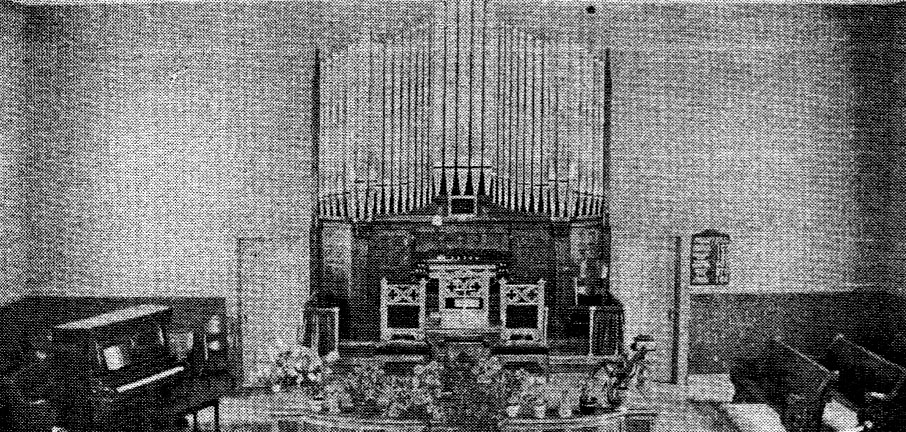
|
On April 4, 1905, John and Martin Bekius presented the church with $1,000 to buy an organ in memory of their mother, who had recently gone to be with the Lord. This organ is the beautiful organ still used in the church. In 1908, Rev. Van Zanten had serious health problems. The consistory minutes reveal that he was absent from several meetings because of ill health. On August 29, 1908, Rev. Van Zanten asked the consistory for a three-month leave of absence for health reasons, which was granted with pay. In October, 1908, while on a visit to South Holland, Illinois, he died in a most tragic manner. His successor was Student M. D. Van Der Meer, ordained and installed on June 9, 1909. During Rev. Van Der Meerís pastorate here tow notable things happened. On May 19, 1910, the congregation voted to buy new pews for the church, and in March, 1911, a telephone was installed in the parsonage. Things were beginning to get modern! In May, 1911, Rev. Van Der Meer accepted a call from Eighth Reformed Church in Grand Rapids, Michigan. After being vacant a year and a half, Beaverdam called Rev. TePaske. He was installed as pastor on January 31, 1913. On March 27, 1913, Elder Peter Huyser passed away, at age 91, to be with the Lord. He had faithfully served as Elder for 35 years, without intermission, until his death. In July, 1913, our first Sunday School picnic, an all day affair, was held. What the reasons were is not apparent from the consistory minutes, but the relationship between Rev. TePaske and Beaverdam Reformed Church deteriorated to such a degree that the Pastoral Relations Committee, of Classis Holland, considered it in the best interests of all parties to sever the relationship between the pastor and the church. The consistory agreed to pay Rev. TePaske three monthsí salary as severance pay. Rev. Tepaske soon accepted a call to the Three Oaks Reformed Church, Three Oaks. In June, 1917, the church decided to build a new parsonage, at the estimated cost of $3,500, to replace the first one built in 1873. The old parsonage was partly dismantled, but a sizable part was sold in one piece, and is now the main portion of a farmhouse located near the corner of 72nd Avenue and Quincy Street. On March 28, 1919, a congregational meeting voted to have tow English language services each month. Early in 191, the Bekius family offered to build a consistory room for the church in memory of Sjoerd Bekius. This building, now called the chapel, was first built separate from the church building, (where the parsonage now stands) and later moved and annex to the church. In the same year also, the church changed from the "common cup" mode of celebrating the Lordís Supper, when the Ohlman family presented the church with a new communion set. After a vacancy of more than two years, Rev. Herman Maassen was installed as pastor of Beaverdam on July 2, 1919. |
Blendon Reformed 50th Anniversary
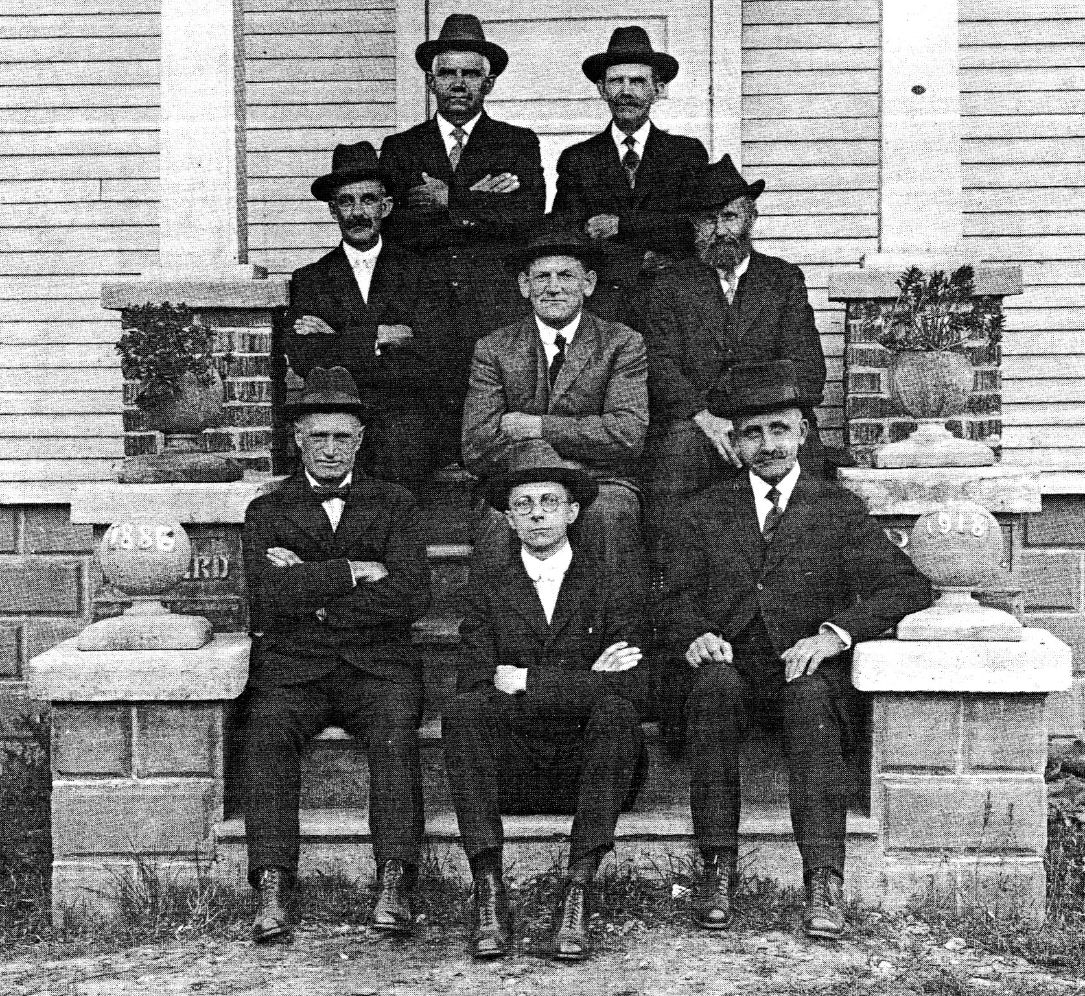
1920 Consistory
Front Row: John Brouwer, Rev. H. Maassen,
Cornelius Van Farowe
Second Row: Gerrit Huyser, John Feenstra, John Hop
Third Row: Dave Bekius, Reindert Knap
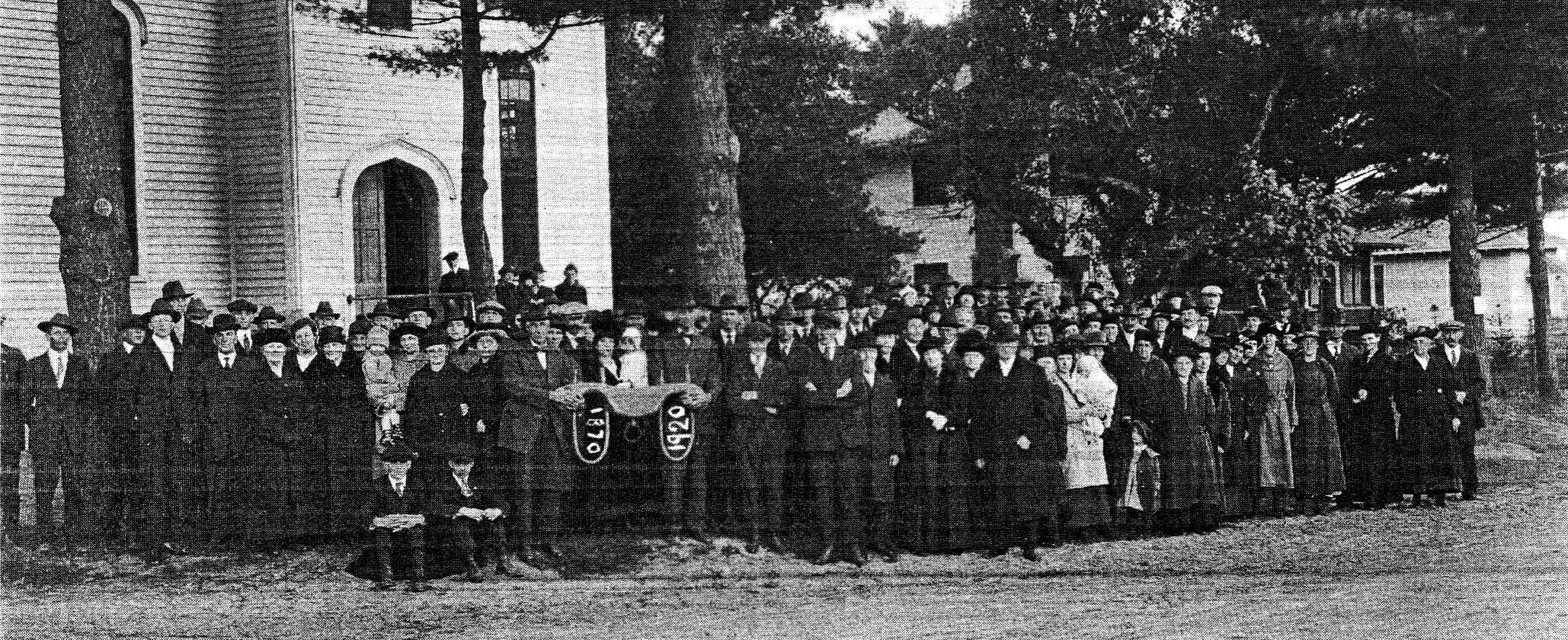
Beaverdam Reformed Church, 1870 - 1920
In the consistory minutes of year 1920, mention is
made of the passing of J. Westrate, who drew the plan of the church, and
supervised the construction. On September 13, 1920, the consistory mourned the
death of one of its members, Cornelius Boertje. We quote from the minutes; "He
not only possessed exceptional God given talents, but he was always investing
these talents in the Kingdom of God, so that the Lord might profit from them. He
was not ashamed of the Gospel of Christ, having experienced in his own soul that
it is the power of God unto salvation. After a life in many ways eventful and
troubled, he has entered into the rest that remaineth for the people of God." On June 13, 1921, the consistory moved to begin using
collection plates to take up the offering, "whenever they might be presented as
a gift to the Church." In July, 1922, Rev. Herman Maassen accepted a call to
become the pastor of Hope Reformed Church in Sheboygan, Wisconsin. A year and a
half later, the congregation extended a call to Student David Bogaard, who was
ordained and installed as our pastor on June 6, 1924. A young girlís society,
"The Busy Bees," was organized by Mrs. Bogaard. Beginning August 18, 1924, the church records were
kept in the English language. Prior to this time, all records were written in
the Dutch language. According to a set of by-laws adopted at this time, our
church had a Holland language service beginning at 9 a.m.; and an English
language service at 1:30 p.m. each Lordís Day. For election to an office in the
church a two-thirds majority vote was required. On September 29, 1920, the church celebrated its
fiftieth anniversary. In May of the same year, the Consistory auctioned off the
buggy, cutter, and the barn belonging to the church. Still later in this year,
decisions were made to enlarge the church basement, and install a generating
plant to furnish electricity for lighting the church and parsonage. In the early days of the church, it was customary for
the consistory to occupany an "Elders and Deacons" pew in the front of the
church during services. In 1927, this time-honored custom was abandoned. Rev. Bogaard accepted a call to Marion, New York in
April, 1928. Two months later a student, Mr. N. Bruinix, was engaged to serve
here as Regular Supply for the summer months. In October, 1928, we extended a
call to Rev. Carl Schroeder, which call was declined. On January 30, 1929,
Beaverdam extended a second call to Rev. Schroeder, which call was accepted. In 1930, an invitation to attend and vote at all
congregational meetings was extended to "all females who are members, and 18
years old or older." In May, 1932, in the depth of the great depression,
Rev. C. Schroeder voluntarily asked the church to reduce his yearly salary from
$1,800 to $1,500. The following year he requested the consistory that his salary
for that year be cut to $1,200. In November, 1936, Rev. Car. Schroeder accepted a call
from Peopleís Park Reformed Church of Patterson, NJ. In this year also, the old
horse stable was broken down. The stable, a familiar feature of country churches
in the horse and buggy days, formerly stood just west of the church on Ransom
Street across from Huyser store. On January 28, 1937, a call was extended to Rev. Peter
Muyskens, which he accepted. In 1939, the church auditorium was remodeled and
redecorated. Carpet was installed in the front of the church and on the pulpit,
a gift from the Christian Endeavor Society; and new lights in the auditorium
were given by the Ladies Aid women. Then on March 14, 1940, a celebration
commemorated the 70th anniversary of the church. In 1940, Rev. Muyskens accepted a call to Richmond
Reformed Church in Grand Rapids, Michigan. In September of this year, the
consistory engage theological students to teach catechism. They were paid $3.00
for Saturday classes, and $2.00 for Tuesday evening classes. In the fall of this
year, the consistory gave Henry Ohlman permission to use the east end of the
church grounds for pasture, and also to enclose this pasture with an electric
fence, the current to be off during services on Sunday. At the annual
congregational meeting it was moved and carried to support a foreign missionary,
jointly with South Blendon and Hudsonville Reformed churches. At a special
meeting of members of these three churches the following year, decision was made
to share in support of Rev. and Mrs. Joseph Esther. In 1941, the perennial language question came up
again. The members had been issued ballots to determine the feelings and wishes
of the Congregation on the matter, with the following results: 42 for all English language services on the Lordís
Day. On March 10, the congregation "after peaceful
discussion" voted for all English language services, every other Lordís Day. After being without a pastor for almost tow years, a
call was extended to Rev. August Tellinghuizen in March of 1942. He was
installed as our pastor on April 30, 1942. In July a book entitle "Reformed
Church in Action" was given to each family in the church; and good reading
material was sent to the boys from our church in the service of our country. At the annual congregational meeting, the language
question was again discussed, and it was decided to have one Holland service
once a month beginning January, 1943. Rev. Tellinghuizen also started the
practice of preaching a short childrenís sermon in the afternoon service. In
April of 1944, a frame containing the pictures of our men in the service of our
country was put up in the rear of the church. It was also decided in this year
to put up an addition to the kitchen and remodel the interior, the Ladies Aid
having permission to plan the kitchen for their conveniences.
35 for all English language services every other Lordís Day.
26 for no change in the custom of one Holland, and one English language service,
every Lordís Day.
75th Beaverdam Reformed Church Anniversary
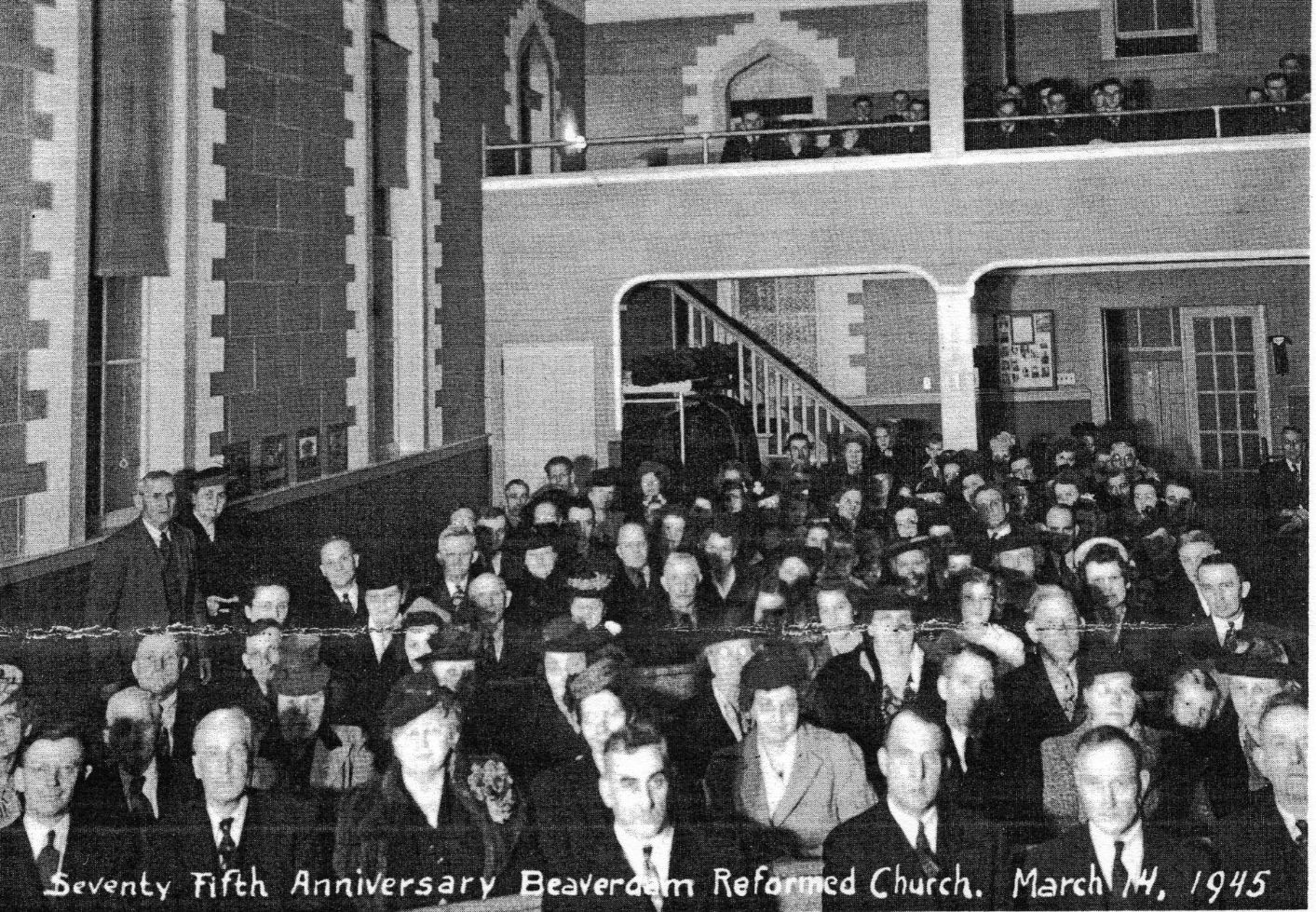
Left Side of Church
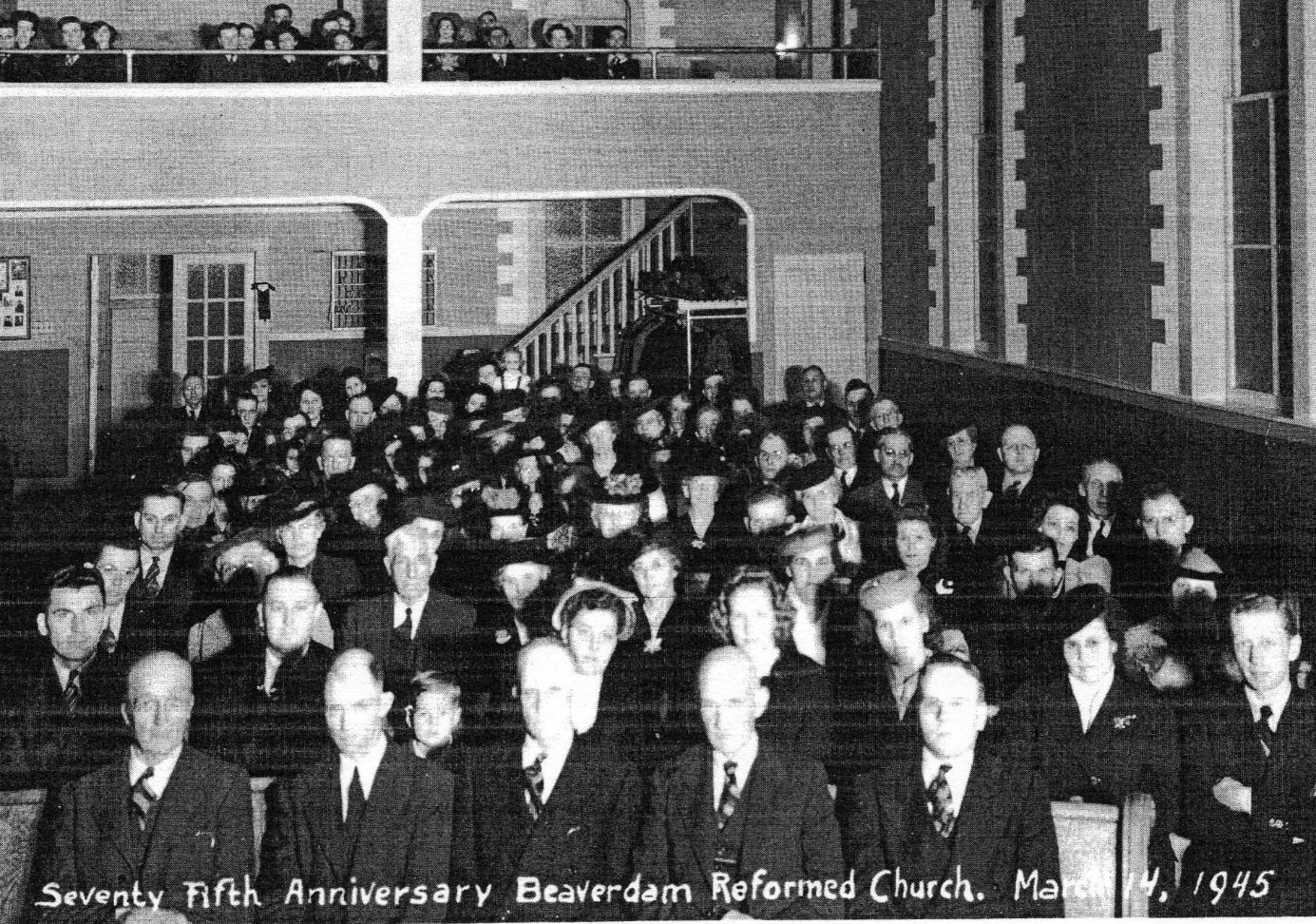
Right Side of Church
In February plans were begun to celebrate the 75th
anniversary of our church in March of 1945. The day of the celebration was
saddened by the news of the death of John DeBoer, who was killed in the service
of our country in Luxembourg, Germany. Memorial services were held for him in
our church in May. Then again on April 22, 1945, another son of the
church, Foster DeVries, was killed while serving his country in Italy. Memorial
services were held in our church on May 27, 1945. In June of 1945, Rev. Tellinghuizen accepted a call to
1st Reformed Church of Lansing, Illinois. Four months later a call
was extended to Rev. Henry Rozendal which was declined; but in January of 1946,
a second cal was extended to him. He began his work here in March of 1946. At the congregation meeting in 1947 it was decided to
have morning and afternoon services in December, January, February and March;
and to have morning and evening services in the remaining months. It was decided
to take a free will offering on February 22 for Arthur Brower, who was leaving
as a missionary to Africa. There was much interest in missionary work among the
women who were unable to meet with the Womenís Mission Society in the afternoon
due to small children at home. Therefore, Mrs. Rozendal felt the need to
organize another mission society. The new society called, "The Mission Guild"
was organized with 15 members in March of 1949, under the leadership of Mrs.
Rozendal. In the same year, many of the pine trees on the church
property were cut down, and the lumber was kept for future use in the church. Rev. Rozendal accepted a call to the Portage Reformed
Church and left here in October, 1949. In January of 1950, a committee of four was appointed
as a building committee to investigate the cost of remodeling the church
basement in order to make more use of the basement for Sunday School purposes.
During the summer the chapel was moved and annexed to the church, and the church
basement was remodeled. The lumber, made from the pine trees on the church
property, was not put to use as knotty pine paneling on the walls in the church
basement. Jack Van Dyken, student at Western Seminary was engaged as regular
supply for the summer months. He and his family lived in the parsonage. Then in
September, Student Van Dyken was given $20 per week, free home and Consumerís
bill up to $3 paid by the church for his continued services. A farewell was held
for the Van Dyken family in April after he accepted a call to become the pastor
in Forest Grove Reformed Church, upon his graduation from Western Seminary in
June. In January of 1952, Jay Weener accepted the call
extended to him to become our pastor after his graduation from Western Seminary
in June. On April 14, 1852, the official call of the Beaverdam Reformed Church
to Student Jay Weener was signed by members of the consistory and the moderator
Rev. John Potts of Vriesland. A congregational reception was held for the
Weeners on May 29, 1952. Mr. Cornelius Vereeke was given a bonus of $50 for his
20 years of daithful janitor service. Then in June, a farewell service and
reception was held for Mr. and Mrs. LaVerne Sikkema before they left to begin
their missionary work in Africa. A love offering was taken at the dedication
services for the Sikkemas to be given to them. The church and Sunday School now
share in their support. In March of 1955, when one of our elders, Richard
Huyser and his family, left to join the newly organized Zion Reformed Church of
Grandville, a gift of $100 was given from the Beaverdam Church to the new Zion
Church. In April, Rev. Jay Reener accepted a call to the Third Reformed Church
of Grand Rapids. He preached his farewell message May 8, 1955. The congregation
then, after extending two pastoral calls both of which were declined held a
special congregational meeting in Januar, 1956, when a call was extended to Rev.
Harold Lenters of Woodstock, Minnesota. He accepted the call to become our
pastor, and began his ministry here in March of 1956. In November, 1956, Mr. and Mrs. Lawrence De Vries
presented the church with the present Baptismal Fount in memory of their son,
Foster, who was killed in military service. In December, it was decided to take on an additional
missionary project, a share in the support of Rev. Carl Schroeder (our former
pastor) who was then serving a congregation in Calgary, Alberta, Canada. In the spring of 1958, new hard coal furnaces were
installed in the church and chapel. In May, 1959, Rev. Harold Lenters accepted a
call to the newly organized church of Sheboygan, Wisconsin. In June, a call was extended to Rev. Jacob Blaauw who
was serving the Board of Missions in Canada. The call was declined. In August,
the congregation felt it wise to build a new parsonage. A special Congregation
Meeting was held on October 19, 1959. The building committee presented three
different plans for the new parsonage. Then in December, 1959, a second call was extended to
Rev. Blaauw which he accepted. Plans were made for moving their household and
personal belongings to Beaverdam. In Marech, the 90th anniversary of
the church was celebrated by having a program which was sponsored by the
Christian Endeavor Society. At this time pictures were taken of the
congregation. When Rev. Blaauw left in 1965, he was eventually
replaced by Rev. Louis P. Kraay, who was pastor at the time of the churchís 100th
anniversary.
Consistory Members, 1870 - 1970
|
NAME |
|
BARENSE, JACOB |
|
BEKIUS, D. |
|
BELD, H. J. |
|
BELD, T. |
|
BERENS, FRED |
|
BERENS, GERRIT |
|
BERENS, HERMAN |
|
BLOK, ARIE |
|
BOERTJE, C. |
|
BOES, EGBERT |
|
BOHL, HAROLD |
|
BOWMAN, ALFRED |
|
BOWMAN, HARRY |
|
BROWER, ADRIAN |
|
BROWER, HARVEY |
|
BROWER, JOHN |
|
BUSSIS, JOHN |
|
DALMAN, M. |
|
DALMAN, R. |
|
DE BLAAY, ADRAIN |
|
DE BOER, FRANK, JR. |
|
DE BOER, FRANK, SR. |
|
DE GRAAF, E. |
|
DE JONG, THEODORE |
|
DE JONG, THYS |
|
DE JONGE, CHRIS |
|
DE VRIES, FOLKERT |
|
DE VRIES, GLEN |
|
DE VRIES, LAWRENCE |
|
DRIESENGA, HARVEY |
|
EBELS, J. |
|
ELLERS, R. |
|
ELZINGA, H. |
|
FEENSTRA, HENRY |
|
FEENSTRA, J. |
|
FORMSMA, ROBERT |
|
HASSEVOORT, HAROLD |
|
HEIHN, HAROLD |
|
HIRDES, JOHN |
|
HOLSTEGE, GERRIT J. |
|
HOLSTEGER, H. |
|
HOP, DALE |
|
HOP, J. |
|
HOP, JOHN |
|
HOP, NORMAN |
|
HUIZINGA, A. T. |
|
HUIZINGA, JOE |
|
HUIZINGA, TOM |
|
HUNGERINK, JOHN |
|
HUYSER, C. |
|
HUYSER, CLIFFORD |
|
HUYSER, CYRENE |
|
HUYSER, D. |
|
HUYSER, MAURICE |
|
HUYSER, O. |
|
HUYSER, P. |
|
HUYSER, PETER D. |
|
HUYSER, RICHARD |
|
IREY, ROBERT |
|
JAGER, L. |
|
JONKER, GERRIT |
|
KNAP, ARIE |
|
KNAP, KENNETH |
|
KNAP, REINDERT |
|
LEENHOUTS, C. |
|
LEENHOUTS, JAMES |
|
MACHIELA, CHESTER |
|
MULDER, EARL |
|
OHLMAN, GEORGE |
|
OHLMAN, HENRY |
|
SCHEELE, M. |
|
SCHUT, ANDREW |
|
SCHUT, D. |
|
SHOP, SHERLEY |
|
SMITH, PAUL |
|
STURING, L. |
|
SWARTWOLT, C. |
|
TOP, T. |
|
TOP, WILLIAM |
|
TUBERGEN, MARTIN |
|
VAN FAROWE, ALBERT |
|
VAN FAROWE, C. |
|
VAN FAROWE, HENRY |
|
VAN WIEREN, H. |
|
VELDMAN, ED |
|
VELDMAN, GEORGE |
|
VER HULST, A. |
|
VER MEULEN, WILLIAM |
|
VEREEKE, AREND |
|
VEREEKE, D. |
|
VEREEKE, WILLARD |
|
WESTRATE, J. |
|
WITTENGEN, H. J. |
|
ZOET, J. |
Transcribed and Scanned by ES
Created: 7 Sep 2013